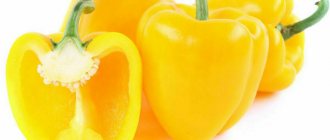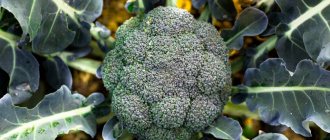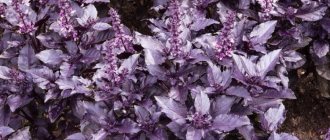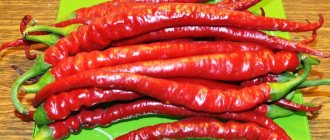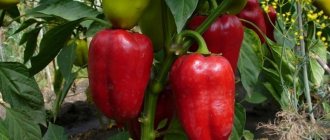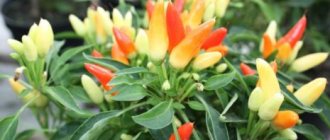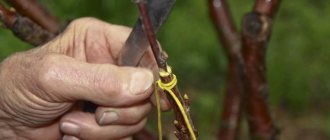Description
Decorative indoor pepper belongs to the Solanaceae family. This plant is also called capsicum. South America is considered its homeland. It was from there that it was brought to the territory of Eurasia.
Previously, capsicum was planted in open ground, used to decorate the landscape. Only relatively recently did they begin to grow hot pepper in a pot as a houseplant.
As can be seen in the photo, it has the shape of a bush, the height of which can vary from 0.15 to 1.2 m. There are both annual and perennial species.
Chili peppers at home on the windowsill can bear fruit for 4-5 years. The appearance of different varieties may vary. Leaves can be elongated and sharp.
There are also specimens with oval or ovoid leaves. The color scheme of the ground part can vary from light shades of green to dark. The color of the flowers is predominantly white. Flowers are collected in inflorescences or arranged singly.
The colors of the fruits are striking in their diversity. These can be yellow, red, orange, purple tones. The color also depends on the degree of ripening of the fruit. In addition, peppers can have different shapes - oval, round, ovoid, etc.
A peculiarity of the plant is that the flowering and fruiting periods are not separated in time. You can enjoy the sight of flowers and fruits at the same time. Another interesting nuance is the abundant yield.
Edible varieties of decorative hot peppers
Variety of decorative hot pepper “Little Miracle”
This little miracle plant is quite large for its species; an adult plant reaches a height of 50-80 cm, which makes it quite large among the varieties of ornamental peppers.
But it was not called a miracle for nothing; the ripening of its fruits can truly be called a miracle; like an iridescent garland, it changes the color of its fruits as they ripen. At the very beginning of ripening, the fruit has a characteristic green color, but after that it becomes purple, then as it ripens it becomes yellow, then orange, and at the very end, when the fruit is already ripe, it turns red.
The leaves of this variety are the same as those of ordinary peppers, oblong-oval with elongated pointed ends.
The fruits of this variety are used for pickling vegetables and preparing dishes from them..
Variety of decorative hot pepper “Medusa”
Medusa is a very unusual variety of ornamental pepper . It got its name for a reason; this bush looks like a jellyfish that has stuck its tentacles out of a flower pot. What makes it so unusual is its fruits, they are long, reaching 5 cm, the fruits are thin and very similar to tentacles. At the beginning of ripening, the fruits have different colors, yellow, white and orange, and when ripe they all turn red. All colors can be in the pot at the same time, making it very colorful and unusual.
The leaves of the jellyfish also have an elongated shape, the same as the fruits themselves, creating an unusual appearance of a bush.
The jellyfish grows small, the plant reaches a maximum height of only 25 cm, and the diameter of the bush is no more than 16 cm.
This variety has a very piquant taste of fruits , which are used for cooking meat dishes and pickling.
Variety of decorative hot pepper “Ogonyok”
Many have known the flame since childhood; many of us grew this pepper in our grandmother’s kitchen. This variety is very early ripening; the first fruits on the bush will appear after 4 months of planting. Its fruits are bright red, which confirms its name. The fruits themselves are not small; the weight of one fruit can reach 50 g.
Ogonek is a medium-sized variety; the shrub can reach a height of 40 cm.
The leaves are oval with pointed ends.
The fruits are used for preparing meat dishes or simply for consumption, with any dishes as a snack..
Variety of decorative hot pepper "Aladdin"
Aladdin is an ultra early ripening variety . It bears fruit very abundantly and you can harvest quite a lot from it, and it looks simply magnificent with a large abundance of fruits on the bush. Its fruits are oblong and have the shape of a cone. As they ripen, the peppercorns change their color very effectively. At the very beginning they are green, and then they change color. When semi-ripe, they turn yellow or orange, then purple; when the fruits are fully ripe, they turn red.
The bush of this variety grows of medium size, its growth does not exceed 40-50 cm in height.
Peppers have a very piquant taste and aroma with their inherent pungency , but they are not as hot as the Ogonyok variety. They are used for meat and vegetable dishes.
Decorative hot pepper variety "Phoenix"
Phoenix is a mid-season variety ; its fruits ripen within 90 days. The peppers themselves are cone-shaped, their average size is 3-4 cm. The fruits change color as they ripen. At the very beginning they are green, then become pale yellow, and when ripe they are red. There are quite a lot of fruits on one bush and it bears fruit often.
The bush has an excellent decorative shape, there is no need to shape it, it grows in a spherical shape. Its size is small, it grows only up to 35 cm maximum.
Peppers are used as a seasoning for various hot dishes, and they can also be preserved. For use as a seasoning, it is best to dry them.
Variety of decorative hot pepper “Salute”
Salute is a small decorative pepper ; it grows only up to 20 cm. It is valued for its decorative qualities; a representative of this variety has the correct rounded shape of the bush and does not need pruning to form; it has a beautiful shape by nature. It is very often used as a decorative element.
The salut fruit has the shape of a cone with a characteristic pointed end. At the beginning of ripening, peppercorns are always dark green; when ripe, they turn orange. The surface of the fruit can be smooth or slightly ribbed. Each peppercorn weighs about 6 grams. It is very spicy with a pleasant aroma. Peppers are used as a seasoning or for preserving vegetables or meat.
Variety of decorative hot pepper “Explosive Amber”
Explosive Amber is an early ripening variety ; only 120 days pass from sowing the seeds to ripening the fruit. It does not grow as a large bush, its growth reaches no more than 30 cm in height.
Its fruits are very beautiful due to their varied colors; they make the pepper bush a real bouquet. Initially they are green or purple, gradually as they ripen the color turns into cream, then pink and finally they become scarlet. A bush can have all the colors at once, creating an incredible range of colors. The length of each pepper is approximately 2.5 cm. The fruits are quite spicy and are used as a seasoning.
This variety is distinguished not only by its multi-colored peppercorns, but also by its leaves; they have a beautiful purple hue.
Variety of decorative hot pepper “Bell”
The Bell variety has a very unusual appearance; its highlight is its fruits; they have a shape that is not standard for peppers . Its peppercorns are not like all the others, they are not cone-shaped, but rather like bells, but they even look more like small squash that hang on the branches of a bush. They are flattened and similar to the shape of a regular pepper only in the tip, which is pointed and slightly protruding.
At the beginning of ripening they are green; ripe peppers turn red. Its flesh is sweet without pungency, but the white veins and seeds are sharp. The weight of each fruit ranges from 60 to 100 grams, which makes them quite large for ornamental pepper varieties. The branches and leaves of the bell are always slightly drooping.
Variety of decorative hot pepper “Nosegay”
Nosegay is one of the smallest representatives of ornamental peppers . Its size is only 15 cm in height maximum.
This pepper does not require a large pot; a 1 liter pot will suffice.
The highlight of this variety is its fruits; they are round in shape and look like New Year’s balls hung on the branches.
At the beginning of ripening they are green, as they ripen they change color to yellow, then orange and when fully ripe they turn red. They taste medium hot and can be used as a seasoning .
Variety of decorative hot pepper "Filius Blue"
Filius Blue is so named because of the color of its fruit . At the very beginning of their ripening they have a very unusual violet-blue color, which makes them very striking, but as they ripen they change this color and turn red. Peppercorns are cone-shaped with a rounded tip. The fruits have a pungent taste and are used as a seasoning, mainly in dried form.
This variety differs from others in its more demanding attitude to lighting, watering and requires nutritious soil. The reason for this need is that this variety bears fruit all year round and needs a large amount of nutrients.
Variety of decorative hot pepper "Poinsettia"
Punsettia can be compared to some kind of unusual flower , and all because the peppers of this variety grow in bunches and from a distance it seems that these are not peppers at all, but a flower with long petals. The peppers themselves are indeed long, reaching 8 cm in length. At the beginning of ripening they are green, and as they ripen they turn red. The fruits are used as a seasoning in dried form.
The plant of this variety is of medium size; this bush grows up to 35 cm in height.
Variety of decorative hot pepper “Bride”
The bride got its interesting name thanks to the ripening fruits , which have a peculiar cream color and when there are a lot of them on the bush, it looks like a bride’s dress. Gradually, as it ripens, it becomes bright red. The fruits are cone-shaped and are used as a seasoning and for preserving vegetables.
The plant is of medium size, the bush grows up to 30 cm in height. This variety loves fresh air and in summer it is better to take it outside or to the balcony.
Variety of decorative hot pepper "Jamaica"
Jamaica got its name because of its shape , this pepper has the shape of a diamond and when it has already ripened and begins to fade, the shape of the pepper becomes similar to the well-known knitted beret that Jamaicans wear. Ripe fruits have a bright yellow color. They are used as a seasoning and fresh. Its pulp is sweet, but the white veins and seeds are sharp.
The shrub is medium in size and grows to approximately 35 cm in height depending on care.
Variety of decorative hot pepper “Queen of Spades”
The Queen of Spades is one of the most beautiful representatives of decorative peppers . Its highlight is the color of the fruits; when they ripen, they acquire a rich purple color; the shrub looks very beautiful. Its peppercorns have a special aroma and pungent taste. It is consumed fresh, as well as as a seasoning and for preserving vegetables; it looks very impressive in a jar with vegetables, again thanks to its unusual color.
The bush does not grow very large, up to only 25 cm in height. This variety is highly valued for its decorative properties due to the ideal round shape of the bush.
Variety of decorative hot pepper “Black Pearl”
The Black Pearl is not named after the ship from the cult film , it itself deserved its name. This variety of decorative pepper is simply unique in its appearance, its leaves are black, initially they are green, of course, but over time they turn black.
The fruits of this variety look like real black pearls, they are round with a slight elongation and during the ripening period they have the same black color as the fruits, but when ripe they turn dark red.
Variety of decorative hot pepper “Zest of Baggio”
Just a unique variety, but it is no longer valued for its decorativeness . This variety has simply unique fruits; when ripe they become an unusual dark brown color, but the whole highlight is not in this, but in their taste. They have a simply amazing taste; they have an unusual smoked aroma, which is combined with the aroma of raisins. Chefs all over the world use this variety of decorative pepper in their dishes. They are eaten both fresh and dried . It gives dishes a slightly smoked taste and aroma.
Variety of decorative hot pepper “Peter's Finger”
Peter's Finger is a unique variety, its uniqueness and zest lies in its very unusual fruits . The length of each fruit reaches 10 cm, which is quite a lot for a decorative pepper. After ripening, the fruits have a rich yellow or red color. But its uniqueness is not even in its color or its size, but in its shape, which, despite the name, does not at all resemble a finger; in appearance, this pepper looks like a real man’s dignity.
Humidity and temperature
The plant loves warmth. It is optimal to provide a temperature of 25°C for growing hot peppers on a windowsill in spring and summer. In the cold season, it should be reduced to 15 - 18°C. In summer, if possible, take the bush to the balcony or garden.
As for humidity, it should be moderate. Regular spraying is encouraged. In the warm season - once every half month, in the winter - once a month. Bathing in the shower is allowed.
Features of care in winter
In winter, plants lack light and heat, and therefore they need to be properly cared for. Daylight hours should be 12 hours. The temperature during the day is not lower than +25°C, at night - not less than +15°C. In cold weather, it would be useful to illuminate the plants with a regular incandescent lamp.
Avoid drafts and excessive soil moisture, because in winter moisture usually evaporates much more slowly. Periodically loosen the soil and occasionally wipe the leaves from dust (once a week will be enough). You can spray peppers with a spray bottle if the room is well heated. Otherwise, it is better to refuse water procedures.
Illumination
Organizing proper lighting is an important point in caring for indoor peppers at home. In order for the bush to grow normally, it is better to place the pot with it on a window facing west or south. The southwest direction is also suitable.
The shrub needs to be provided with as much light as possible. Moreover, the lighting should be diffused - direct sunlight has a negative impact on its health. Insufficient lighting can lead to a lack of harvest, reduced decorativeness and leaf fall.
Inedible varieties of ornamental peppers
In principle, all varieties can be eaten, but there are 2 varieties that are strictly prohibited due to the toxicity of the fruit . But I don’t mind this drawback, they look very beautiful and are worthy of decorating your kitchen.
Variety of inedible hot pepper "Clown"
Clown refers to varieties that are used exclusively for decorative purposes . Its fruits have a round or slightly elongated shape. The fruits have different colors at the same time; fruits of yellow, orange and red colors hang on the bush, which looks simply great.
It does not grow large, up to a maximum of 35 cm in height. The bush is very lush.
Inedible pepper variety Goldfinger
Godfinger is a variety that you, of course, cannot eat, but you can decorate your home with it. It has very beautiful bright yellow fruits up to 5 cm long. It bears fruit very profusely, and peppercorns almost always appear on it. This variety loves the sun very much and prefers a sunny side. It grows as a small bush up to 25 cm in height.
Choose the varieties that suit you best and have fun growing and harvesting!
Source: ogorodland.ru
Reproduction
Indoor peppers can be propagated in one of two ways:
- generative (from seeds);
- vegetative (using cuttings).
There are two methods to grow a plant from seeds. Sequence of actions for the first method:
- Select pots with a volume of 4 to 6 liters, fill them with soil, not forgetting to arrange a drainage layer.
- Pour the seeds into the water and leave to soak for 60 minutes. Then put them in a damp cloth for a day.
- Plant them in prepared containers and sprinkle a small amount of soil on top. The soil should be moist.
- Cover everything with film or glass and place it in a warm room. Remember the need for regular ventilation and moisture. As soon as the first 4 leaves appear, pinch the top to begin crown formation.
The second method is to grow seedlings and transplant them as they grow.
Propagation through cuttings can be carried out both in spring and summer. This method involves cutting off side shoots and placing them in separate pots for rooting.
If you love aesthetics, then be sure to buy yourself a decorative pepper. With its help you can decorate any window sill or balcony. In addition, its fruits will be useful when preparing culinary masterpieces.
Description and characteristics of ornamental peppers
Indoor peppers can produce edible and inedible fruits. Ornamental peppers have the following general characteristics:
- small height of the bushes, which most often is 25-45 centimeters. But there are exceptions to the rules, there are varieties that can reach a height of 1 meter;
- fruit size, weight does not exceed 90-100 grams;
- the bushes are very neat, you don’t need to form them yourself;
- subject to optimal conditions in the room, the plants will bear fruit throughout the year.
Plants love sunlight, so place pots on the sunny side of the house. Plants should be watered only with warm water, so as not to provoke the manifestation of blackleg disease.
Pepper fruits can be:
- sweet or spicy;
- round or cone-shaped;
- yellow or red.
Varieties with unusual fruits
Not all varieties of indoor peppers bear oblong fruits. There are many varieties with round or other shaped peppers. Below are some of the most common varieties.
Indian summer
The plant grows well in the shade and does not require special care. Forms a compact, voluminous bush with small leaves. Flowers are white or inky. Peppers grow in different shapes and colors, and there is a pronounced pungency.
Habanero red
This variety bears very hot fruits and is characterized by high yield. The shape of the peppers resembles physalis. They reach a size of 4 cm, the skin has a ribbed surface, and they have a pleasant fruity aroma. The weight of one fruit is 15 g. The bush needs abundant watering.
Rainbow
The variety bears small, round-shaped fruits and looks decorative. The tip is slightly elongated. The fruits change color as they ripen, so there are multi-colored peppers on the bush at the same time.
Bell
These fruits have the original shape of a bell flower. Upon reaching biological ripeness, they acquire a scarlet color. They are distinguished by a combined taste: the “petals” are sweetish, closer to the core you can feel the sharpness. Spicy seasoning for meat dishes.
Nosegay
Refers to the most compact varieties. The bush grows up to 15 cm high; the round pepper also has a miniature size. As it ripens, the color changes several times: first green, then cream, yellow and finally red. A small liter pot is enough for this plant with round fruits. The peppers taste moderately hot.
Rowanushka
One of the most decorative varieties. The leaves have an unusual shape, resembling a boat, with edges curled inward. The peppers are round, small, and resemble rowan berries. The fruits are placed inside the leaves.
Growing and care
You can achieve beautiful flowering and numerous harvests if you provide the plant with an optimal indoor microclimate.
Selection and preparation of soil, containers, seeds
First of all, they determine the variety that they plan to grow (spicy, sweet, with fruits of what color and shape). It is better to buy seeds from trusted suppliers or exchange them with other pepper lovers. Seeds of ornamental peppers retain their germination capacity for 5 years, but this ability drops every year, so fresh seeds collected at most last season are best suited.
The selected specimens must not have damage, specks, signs of rotting or other flaws. Seeds of good quality, pale yellowish in color. First, the empty seeds are separated by placing them in a saturated saline solution. Those that float up are thrown away, the rest are disinfected with potassium permanganate, then soaked in potassium humate. After this, they put the grains in a damp cloth and wait for the root to appear, transplant them into the desired container and germinate at a temperature of +25 ℃. You can plant it in the soil immediately after soaking.
Seedlings in cups
To grow seedlings, select low containers or peat tablets. As they grow, the peppers are transplanted first into small cups or pots, and then into larger containers.
Neutral soil is suitable for planting peppers. They are planted in as loose soil as possible, into which air and moisture easily penetrate. You can take soil from a greenhouse and add some clean, fine sand to it. If garden or other soil is taken from open areas, it is first calcined or disinfected by spilling it with a solution of potassium permanganate. Ready-made soil for peppers mixed with vermiculite and sand is suitable.
When and how to sow
Ornamental peppers are usually propagated using seeds. The planting time for early spring varieties is from early November to late December. Autumn ones are planted in July or August, summer ones - in April and May. The seeds are planted in small pots with a capacity of 200 ml, placing them in a layer of fertile soil to a depth of 1 cm. Sprinkle a little soil on top or lightly “sink” into it. Cover with glass or film. Place in a warm room ( +23 to +25°C ). The cover is removed daily to remove condensation and check the soil for moisture. If necessary, moisten the soil with a spray bottle.
After 10 days, shoots will appear. The seedlings are transferred to a well-lit windowsill. The glass (film) is removed. After another 5 days, the ambient temperature is reduced to +18°C. The soil is moistened as necessary with warm, settled water.
Strong and friendly seedlings
When 2-3 full leaves are formed, the seedlings are removed with a clod of earth using a special spatula or fork. Transplant each into a separate container. Water and keep in partial shade for the first 3 days.
To grow peppers, it is not necessary to pick, but if this is assumed, plants are picked when they have 1-2 pairs of true leaf blades. When picking, the prepared container is filled with substrate, compacted, a depression is made and the seedling is placed in it. It is important to ensure that the root fits completely into the hole and does not bend. Otherwise, pinch it and press it tightly into the hole with a peg. Leave the container with seedlings under fluorescent lights.
When 5 true leaves appear, decorative peppers are transplanted into 3-5 liter pots. This is a permanent place for home beauties. A layer (3-4 cm) of drainage is placed in the pot, for which expanded clay, pebbles, and broken slate are used.
Advice! Several peppers should not be left to grow together. In this case, the weak ones will be stunted in growth and will not bloom or bear fruit.
Every year you should replant into a pot with new soil, transferring the plants into a new container so as not to damage the fragile roots. If you don’t want to injure the plant, you can replace part of the substrate with fresh one, if the volume of the pot allows. This way the plant will not experience stress, as during transplantation, and will begin to bear fruit faster.
When planting, do not use pots that are too bulky. A large amount of unnecessary soil will lead to its souring from moisture. It is better to gradually move the plant when the roots appear from the drainage holes. During the season, 2-3 transshipments will be required.
Young seedlings bloom about a month after germination. The primrose often turns out to be empty and falls off, but over time stronger buds, inflorescences, ovaries and fruits will appear.
Selecting a location, lighting and temperature conditions
Capsicum ornamental peppers prefer intense but diffused light. With a lack of lighting, it produces few leaves, flowers and fruits. But in intense direct light, the plant should be shaded so that it does not get burned. In winter, when daylight hours decrease, peppers must be illuminated with phytoluminescent lamps. This will ensure year-round fruiting.
Peppers are placed on a windowsill with intense but diffused light
In spring and summer, peppers need moderate temperatures. It must be maintained at a level of +20 to +25 degrees. In autumn and winter (especially if there is no additional lighting), the temperature is lowered to +15°C and watering is limited.
Pepper benefits from temperature changes that occur during the change of day and night, so during the warm season it can be kept in the fresh air. Ventilation is also useful, since stagnant air in the room harms the plant.
Watering and fertilizing
The optimal humidity for ornamental peppers is considered to be 65-78% . It is provided by timely watering and spraying of the plant. Focus on the drying of the top clod of earth. During hot weather, peppers are watered daily, in some cases in the morning and evening. Watering is carried out with settled warm water. Cold water causes stress in the plant, causing its leaves and buds to fall off. After watering, in half an hour, inspect the tray under the pot. Drain off excess water, otherwise the roots will begin to rot. In hot weather, plants are sprayed with water at least once a week to ensure fruit set.
Peppers definitely need feeding
Caring for peppers includes mandatory feeding. Plants respond to alternate application of mineral and organic fertilizers. In the spring, nitrogenous fertilizers are applied, and in the summer, once a decade, complex phosphorus-potassium fertilizers are applied, which are necessary for the formation of inflorescences. In the fall, feeding is reduced, and in winter they either do not feed at all (if there is no supplementary lighting), or do this once every 21 days.
Important! The peppers themselves give a signal about the need for fertilizing. If the leaf blades turn purple, the plant needs phosphorus; if they become lighter, the plant needs nitrogen. It is better not to wait for such signs, but to fertilize every 2 weeks.
Bush formation and pollination
Bushes of perennial domestic peppers are regularly removed from old, dried branches and leaves so that the bush is renewed, beautiful, fluffy, and tidy. Pruning is carried out in the spring every two years. First, remove the shoots from which the fruits have recently been removed, and those that are directed inward. Cut the shoots by half or more, but it is important not to overdo it. Pruning is necessary for perennial peppers to enhance the growth of young branches.
For tillering, pinch the top. With each flowering, the very first bud in the branching of the stem and branch is removed.
Trimming a bush helps make it neat and beautiful.
In the first year, pepper does not require the formation of a bush. It will grow to a certain height, which is determined by the varietal characteristics, bloom itself and produce the required number of fruits. It is only important to provide him with comfortable conditions for this.
The plant is self-pollinating, so you don’t have to interfere with the pollination process. If you want more ovaries to form, you can lightly tap the stem during flowering or shake it a little so that pollen falls from the upper flowers to the lower ones. You can use a soft brush to move inside the flowers of decorative peppers.
Prevention of diseases and pests
It is necessary to protect ornamental peppers from diseases. Most often, these plants are damaged by late blight and root rot. Late blight appears as brown spots on leaf blades. It develops due to waterlogging of the soil. As soon as the first signs of the disease appear, it is necessary to treat the plant with preparations containing copper.
Improper watering leads to the development of pepper diseases
Wilted leaf blades of peppers indicate damage by root rot. The solution to the problem is to transplant the plant into new soil. Another dangerous disease of peppers is spider mites. The disease occurs due to violations of air humidity rules, since peppers must be regularly sprayed to keep the air around them moist. Get rid of spider mites using fungicides.
To prevent diseases, it is important to disinfect the soil mixture and provide the peppers with optimal air and soil humidity.
Harvesting
Peppers can be picked as soon as they acquire the color of ripe fruit characteristic of the variety. It can be red, orange, purple.
Important! Timely collection of peppers stimulates the formation of new buds, flowers and fruits. Then flowering and fruiting will be continuous.
Some varieties have fruits that are harvested unripe (they taste better this way). These peppers include Jalapeño.
The joy of a home gardener is a rich harvest!
Fruits grown for seed planting material must be fully ripened. It is better to wait until the stalk dries and the pepper itself can easily be removed from the branch.
Choosing a variety for home cultivation
Varieties with small fruits are best suited for growing indoors. They develop a compact root system that will only need a flower pot to grow. Shade-tolerant peppers are especially suitable for planting on a windowsill.
Advice! It is not recommended to take seeds for planting from fruits purchased in vegetable stores. These varieties are not intended for home breeding.
Although the fruits seem quite small, the plant from which they were collected could reach a height of two meters. Also, such varieties are demanding in terms of lighting and feeding. It is simply not possible to grow such varieties on a windowsill.
For indoor propagation, it is better to purchase a packet of seeds from a specialized store. Below is an overview of the most interesting varieties of hot peppers with fruits of different shapes.
Multi-colored decorative peppers
Although hot peppers are associated mainly with the bright red color in the photo, there are many ornamental varieties with fruits of other colors. If you want to plant a plant with edible peppers in original colors at home, you should pay attention to the varieties listed below.
Jamaica
This variety can be grown on a windowsill in a regular flower pot. It has fruits of an original diamond-shaped yellow color. One of the edible hot peppers, the spiciness comes mainly from the white core, and the walls can be simply sweetish.
Queen of Spades
An evergreen plant with a compact bush. Tolerates shade well. The height of the bush is about 25 cm, the shape is round. Bears purple fruits. Peppers are tasty, hot and aromatic, ideal as a seasoning and also used for canning.
